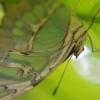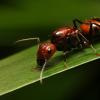Is this a queen? And if so, what species?
1. Location of collection: Corpus Christi, Texas
2. Date of collection: 5/31/2017
3. Habitat of collection: She was on the side of a building.
4. Length (from head to gaster): I don't have a ruler on me, but I included a match stick in the images for an idea of size.
5. Color, hue, pattern and texture: She has a black gaster covered in fine yellow hairs. The rest of her body is maroon and quite dull.
6. Distinguishing characteristics: She is quite big and appears to have wing scars.
7. Distinguishing behavior: Very reactive to light and things around her.
8. Nest description: I didn't find a nest, I just found her walking on a wall. She was not surrounded by workers, she was wandering on her own.
Here are 2 images of her. http://imgur.com/a/X9kQc























